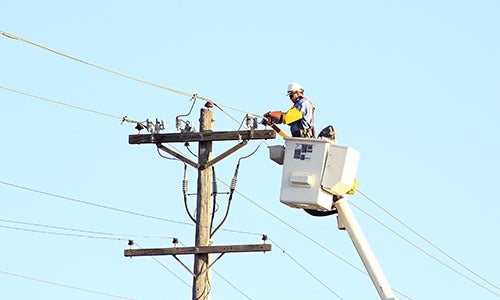Unless the cause of an outage is obvious (like a car hitting a pole) we don’t know how long it will take to find the cause and make the repair until a crew can locate and assess it. During widespread outages, this is even more challenging. After severe storms, it can take a long time just to assess the extent of the damage. Above all, our priorities are in this order: first make it safe, assess the damage, and then restore service. We can only begin restoring power after we have an idea of the problems in the system.
CREC follows a hierarchy of repair to restore power to the most members at once – there are a few reasons for this besides just member count.
If you think of CREC’s electrical system like a network of roads, and those roads leading to your home are blocked, even if your driveway is clear, you won’t make it home. During an outage, problems can occur at any stage of the transmission or distribution system. If there is damage at both a substation and the line delivering power to your home, fixing the service line to your home first isn’t going to help, because the damage "upstream" -- at the substation -- will prevent power from reaching your home.
Often, the damage sustained at the service line level is the most time-consuming to repair. A crew might spend the same amount of time restoring power to a few members as it takes to restore power to hundreds of members.
If your lights blink off and on once or twice, you may be concerned there is something wrong. Usually, this is the result of a temporary problem such as a tree limb on the line that eventually falls off or an animal making contact with lines.
There are devices on our lines called reclosers. Reclosers are a circuit breaker type of device that has the ability to open the circuit for a fault but then to automatically close after a short period of time to restore power. Most problems on a power system are temporary. The recloser senses these issues and attempts to allow the fault to clear before remaining open and creating a prolonged outage. This is very effective in many cases and prevents small problems from causing big ones. In some cases, the fault doesn’t clear and after a programmed sequence of operations, the recloser will open until crews can arrive and clear the problem.
Please be advised there is typically no “power surge” on the distribution network as a result of these recloser operations. It is a lot like flipping a light switch off and back on. There are unique circumstances that can occur which will produce surges within your home. If you have equipment damage, we will inform you when these situations occur.
Yes. CREC has a medical alert registry. When you register for this program, you are placed on a registry list, so every reasonable effort may be made to provide advance notice of a planned maintenance outage. The registry also helps prioritize service restoration when possible after an unexpected power disruption. It is always encouraged that members who are medically dependent on electricity have a backup plan in place (i.e., having a generator, being able to move to a shelter or a family member’s home who has power) if an outage is extensive, and the co-op is unable to quickly provide estimated times for restoration.
A rolling blackout or load shed program, is an intentional shutdown of electricity for non-overlapping periods over different parts of the distribution territory. They are a last resort measure to avoid a total blackout of the power system. Should a severe weather event necessitate load shedding, our generation and transmission (G&T) partners, AECI and Central, are authorized to mandate rolling blackouts across their respective distribution cooperatives, including CREC.
In the past when prolonged and severe weather conditions have impacted our state, AECI and Central requested help from all of its member distribution cooperatives to ask their members to reduce energy usage. That kind of collaborative effort is what prevented the implementation of rolling blackouts – and it is the first step we would take again in extreme weather conditions.
As a distribution cooperative, CREC is just one part of the three-tier cooperative model. We rely on our G&T partners to create and transfer power to CREC which we then distribute to members. If their systems are threatened, our system’s strength becomes irrelevant. If they go down, we go down – it is out of CREC’s control. This is also true if the interconnections of RTOs (regional transmission organizations) are put at risk or fail due to weather. RTOs are responsible for the very complex work of balancing supply and demand for energy on the transmission grid in real-time. RTOs also have the authority to mandate rolling blackouts in dire situations for all of the connected energy providers.
The need for a rolling blackout is not a consequence of problems with CREC's ability to deliver electricity, but rather a direct result of a shortage of power generated. Imagine trying to fill a bucket from an empty well. No matter how good the bucket or how well you draw, the bucket will remain empty if there's no water in the well.
Because we have come so close to having to use rolling blackouts, CREC encourages members to learn more about how severe weather impacts the three-tiered co-op system that serves them and how to be prepared for the possibility. If rolling blackouts become necessary, CREC will do its best to give its members as much advance notice as possible. This will depend on how quickly AECI and Central direct CREC to implement such a mandate. Normally, a rolling blackout lasts anywhere from 2-4 hours, but depending on the circumstances, it could be shorter/longer.
Preparing for outages
To be ready for any weather event that could cause an outage of any kind, we encourage members to have a plan in place, should that outage become extensive. Make sure you have:
· Bottled water and ready-to-eat foods (preparedness experts recommend a three-day supply on hand)
· A manual can opener
· Blankets (for cold weather emergencies)
· First aid kit
· Battery-operated phone chargers, radio, clock, and flashlights, along with extra batteries for these items
· A portable generator
· Friends/family you can stay with should the outage become extensive
In case of very severe winter weather conditions when you’re asked to help reduce power usage:
· Turn down your thermostat a few degrees and use a blanket or warm clothing to help conserve and stay warm
· Limit the use of larger appliances such as laundry or dishwashers
· Use smaller kitchen appliances like toaster ovens, microwaves, and slow
cookers to make meals, rather than relying on your range or oven
· Be sure to turn off and unplug space heaters that you don't need to use
· Be mindful of the amount of time you utilize a space heater and reduce it, if possible
· Keep fireplace dampers closed when not in use
Besides tree branches getting in the way of lines or taking them down during high winds, the next top culprit of outages are animals such as squirrels who chew power lines or get into substations and cause havoc – this happens more than you would think. Vehicle accidents are also sometimes an issue, cars and tractors occasionally hit poles or pull down overhead lines. These outages are especially dangerous because of the potential for an energized line to come in contact with a vehicle full of people.
The crew was likely there to perform a different job in the restoration process, such as a trouble-shooting crew looking for the cause of the outage so they can relay back to dispatch what equipment is needed to make the repairs – i.e., Will flaggers be needed? What about a tree crew? A repair crew will then be sent to the location with the necessary supplies, equipment, and linemen.
During a large outage, crews may arrive with the job of making things as safe as possible first – for members and our lineworkers – disconnecting power, assessing the situation, making safe downed wires, and so on, and then leaving to continue this process at another location where there is damage. The actual repair happens later by a different crew.
Member Resources
Medical Alert Registry

Cuivre River Electric Cooperative offers a Medical Alert Registry program. Every reasonable effort will be made to provide advance notice of a planned maintenance outage.
Streetlight Outage

Notice a streetlight outage in your neighborhood? You can easily report it to us. Click on the link below to notify us of an outage.
Restoring Power Safety and Efficiently

When the power goes out, how do CREC crews know where to start working? It all starts with a safe, efficient plan for power restoration.
